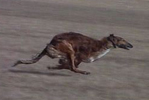 |
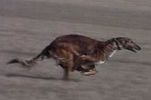 |
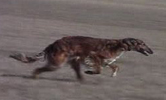 |
 |
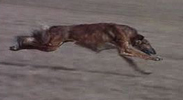 |
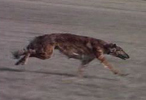 |
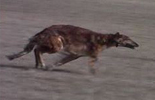 |
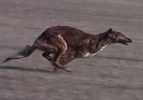 |
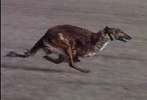 |
A single
galloping stride |
A STUDY COMPARING CONFORMATION TO SPEED IN BORZOI
Anne Midgarden, D.V.M. April 2, 2007
printable copy available at user.nktelco.net/teine/speed2pdf.pdf
 |
 |
 |
 |
 |
 |
 |
 |
 |
A single
galloping stride |
Even the word "borzoi" means swift in Russian. The borzoi was developed over centuries by wealthy noblemen to be a dog with great speed and power. These were large dogs - expensive to hunt and maintain. Their purpose was to put on an impressive show by running down prey out on open terrain. Undoubtedly the different noble families bred dogs most suited to the local prey, climate and territory as well as their own tastes as to color and style. However, speed was the essential characteristic that made a borzoi a borzoi.
This study was designed to help understand what physical characteristics are most essential to borzoi speed.
The American and FCI (2000) borzoi standards were used to determine what anatomical features were measured. Such descriptions as "forelegs somewhat flattened like blades with the narrower edge forward" were measured as width and depth of foreleg at 2 cm above the carpus. Most cosmetic details such as teeth, color, tails and head shape were excluded.
Borzoi included in the study were 2 to 6 years old, in excellent health and condition, bitches not within 30 days post a heat cycle. Borzoi were volunteered by their owners from a wide variety of kennels in England, Germany, and across the United States. Each borzoi in the study was measured standing in show position with hocks perpendicular for the following:
sex____ age_____Height at withers (cm)____________
Height at elbow (cm) _________- taken from floor to point of elbow
Width of chest (in) _________- taken at widest point
Depth of chest (in) _________ -taken at level of T 11
Width of loin (in) _________-taken at level of iliac crest
Depth of tuck up (in)______________ - taken at narrowest point
Width of rear (in) _______________- taken at widest point
Length of back (cm) ___________ - taken from sp. pr. of T1 to sp. pr. of T11
Length of loin (cm) _____________ - taken from s.p. of T11 to iliac crest
Length of croup (cm)________________ - iliac crest to ishiatic tuberocity
Ear set (mm) ______________ - from top of skull to the base of the auricular cartilage
Width of foreleg (mm) ____________ - taken at 3cm above the carpus
Depth of foreleg (mm) ____________- taken at 3cm above the carpus
Length of foot (mm) ____________________ -on ground, from pad to base of toenail.
Elasticity of skin (mm) ____________- taken at withers
Angle of croup (degrees) _____________ lumbar spine & pelvis (iliac crest to ishiatic tub.)
Angle of hock (degrees) _____________ - metatarsals perpendicular
Angle of shoulder (degrees) ____________________ -spinous process & humerus to lateral epicondyle
Angle of pastern (degrees) ____________________ -dorsal surface of carpal joint

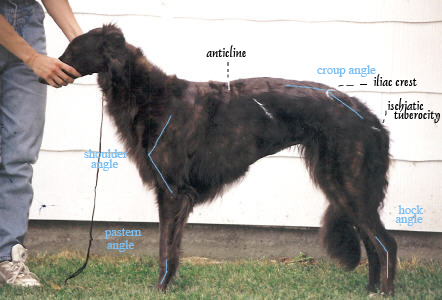
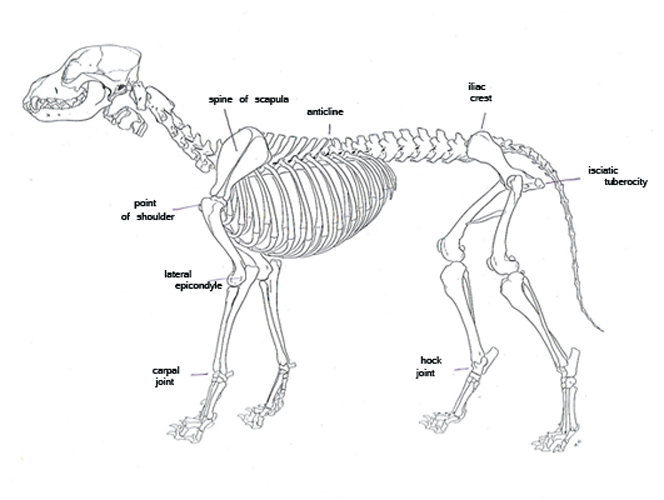
Each borzoi was encouraged to run as fast as possible by chasing after a drag lure made of a rabbit fur squawker through two pairs of electronic eyes set exactly 150 feet apart. They were allowed a 150 foot running start and an approximate 100 foot run off. Dogs who did not appear to be running with maximum effort were excused from the study. Time was measured with a Polaris FarmTek Rodeo Sprint Timer to one-thousandth of a second.
191 borzoi qualified to be included in the study.
This data was analyzed by John D McGinnis, Ph.D., Associate Professor of Finance at Penn State University.
Variables that are compared to speed:
SPEED is 150 feet./seconds per dog
1- HEIGHT = height at withers
2- LEG = height at elbow/ height at withers
3- CHEST = width of chest/ depth of chest
4- LOIN WIDTH = width of loin
5- TUCK UP = depth of tuck up/ depth of chest
6- % LOIN = length of loin/ length of back + length of loin + length of croup
7- CROUP LENGTH = length of croup/ ht. at withers
8- FOOT = length of foot/ height at withers
9- BONE = width of foreleg/ depth of foreleg
10-EAR SET
11- SKIN ELASTICITY
12- REAR WIDTH = Width of rear
13- REAR ANGLE = angle of hock
14- CROUP ANGLE
15- PASTERN ANGLE
16 - SHOULDER ANGLE
17 - REAR SYMMETRY = dogs w/ rear angle greater than croup angle vs. dogs w/ rear angle less than croup angle
Data:
All the data collected is available at: user.nktelco.net/teine/ssdata191.htm
|
Table 1 Descriptive Statistics of the Variables of Interest. |
|||||
|
Panel A: Basic Variables |
|||||
|
Variable |
mean |
standard deviation |
minimum |
maximum |
variation coefficient |
|
speed (feet/second) |
47.48 |
2.41 |
40.62 |
52.34 |
5.07% |
|
withers height (cm) |
77.36 |
3.94 |
68 |
90 |
5.10% |
|
loin width (in) |
5.61 |
0.51 |
4.25 |
7 |
9.07% |
|
ear set (mm) |
32.43 |
5.85 |
20 |
49 |
18.04% |
|
skin elasticity (mm) |
62.79 |
17.89 |
29 |
114 |
28.49% |
|
rear width (in) |
9.59 |
0.56 |
8 |
10.75 |
5.90% |
|
age (years) |
3.47 |
1.34 |
2 |
6.75 |
38.58% |
|
sex (1 = male) |
0.46 |
0.50 |
0 |
1 |
109.67% |
|
Panel B: Angle Variables |
|||||
|
Variable |
mean |
standard deviation |
minimum |
maximum |
variation coefficient |
|
croup angle |
151.68 |
6.08 |
130 |
166 |
4.01% |
|
rear angle |
148.13 |
7.02 |
128 |
164 |
4.74% |
|
shoulder ang |
125.08 |
8.31 |
106 |
152 |
6.64% |
|
pastern |
167.02 |
6.50 |
141 |
180 |
3.89% |
|
Panel C: Relative Variables (Monotonic) |
|||||
|
mean |
standard deviation |
minimum |
maximum |
variation coefficient |
|
|
leg = elbow/withers |
0.54 |
0.02 |
0.47 |
0.58 |
2.95% |
|
chest = width/depth |
0.52 |
0.05 |
0.39 |
0.65 |
10.05% |
|
chest/rear (width) |
0.68 |
0.06 |
0.50 |
0.88 |
9.49% |
|
tuck-up = tuck depth/ chest depth |
0.53 |
0.05 |
0.41 |
0.70 |
9.91% |
|
% loin = loin/(loin+back+croup) |
0.45 |
0.03 |
0.37 |
0.51 |
6.44% |
|
bone = width/depth of foreleg |
0.66 |
0.07 |
0.51 |
0.88 |
9.96% |
|
foot = foot(mm)/withers(cm) |
0.97 |
0.09 |
0.58 |
1.24 |
8.99% |
|
rear sym = 1 if hock angle > croup angle |
0.32 |
0.47 |
0.00 |
1.00 |
144.82% |
|
croup = croup/withers |
0.26 |
0.02 |
0.21 |
0.31 |
6.37% |
The fastest borzoi ran 150 feet in 2.866 seconds = 52.4 ft/sec = 35.7 mph = 57.4 km/hr
Average borzoi speed was 150 feet in 3.16 seconds = 47.48 ft/sec = 32.4 mph = 52.1 km/hr
The slowest borzoi ran 150 feet in 3.693 seconds = 40.6 ft/sec = 27.7 mph
= 44.6 km/hr
Analysis: The collected data was subjected to analysis through three different test types.
The first analysis is below in TABLE 2. It compares the fastest 80 borzoi to the slowest 80 borzoi. In this test the fastest 80 have equal footing with each other, as do the slowest 80. This type of analysis reveals the broad picture of the most important contributors to speed.
|
Table 2 Statistical Tests of Conformation Differences Between the Faster Borzoi and Slower Borzoi |
||||||||||||
|
Fastest 80 Borzoi |
Slowest 80 Borzoi |
|||||||||||
|
Variable |
mean |
median |
minimum |
maximum |
variance |
mean |
median |
minimum |
maximum |
variance |
t-stat |
p-value |
|
htwither |
76.93 |
76.25 |
68.00 |
85.00 |
13.21 |
77.66 |
77.00 |
69.00 |
90.00 |
18.78 |
-1.1564 |
0.2493 |
|
leg |
0.54 |
0.54 |
0.50 |
0.64 |
0.00 |
0.54 |
0.54 |
0.47 |
0.62 |
0.00 |
1.0208 |
0.3089 |
|
chest |
0.53 |
0.53 |
0.39 |
0.63 |
0.00 |
0.52 |
0.52 |
0.40 |
0.65 |
0.00 |
0.9986 |
0.3195 |
|
rear width |
9.67 |
9.5 |
9 |
10.75 |
.2335 |
9.525 |
9 |
8 |
10.5 |
.3839 |
1.6719 |
0.04826 |
|
loin wdth |
5.65 |
5.50 |
5.00 |
7.00 |
0.18 |
5.58 |
5.50 |
4.25 |
7.00 |
0.32 |
0.9502 |
0.3435 |
|
tuck-up |
0.52 |
0.51 |
0.41 |
0.63 |
0.00 |
0.54 |
0.54 |
0.42 |
0.70 |
0.00 |
-2.1018 |
0.0372 |
|
% loin |
0.47 |
0.47 |
0.43 |
0.51 |
0.00 |
0.43 |
0.43 |
0.37 |
0.50 |
0.00 |
10.5319 |
0.0000 |
|
ear set |
29.45 |
29.00 |
20.00 |
40.00 |
20.33 |
35.74 |
36.00 |
21.00 |
49.00 |
32.22 |
-7.7579 |
0.0000 |
|
bone |
0.65 |
0.65 |
0.51 |
0.80 |
0.00 |
0.69 |
0.69 |
0.51 |
1.18 |
0.01 |
-3.9701 |
0.0001 |
|
foot |
0.97 |
0.97 |
0.69 |
1.14 |
0.01 |
0.97 |
0.97 |
0.58 |
1.24 |
0.01 |
-0.0207 |
0.9835 |
|
skin elast |
51.13 |
48.00 |
29.00 |
96.00 |
150.21 |
75.55 |
73.50 |
44.00 |
154.00 |
330.88 |
-9.9601 |
0.0000 |
|
croup angle |
152.34 |
153.00 |
136.00 |
166.00 |
35.01 |
151.10 |
152.00 |
135.00 |
162.00 |
40.07 |
1.2774 |
0.2033 |
|
rear angle |
146.73 |
147.00 |
128.00 |
162.00 |
49.32 |
149.74 |
150.50 |
134.00 |
164.00 |
49.66 |
-2.7083 |
0.0075 |
|
shldr angle |
124.88 |
125.00 |
106.00 |
144.00 |
62.03 |
125.95 |
126.00 |
108.00 |
152.00 |
83.59 |
-0.7968 |
0.4268 |
|
pastern |
167.36 |
168.00 |
148.00 |
177.00 |
25.73 |
166.83 |
168.00 |
141.00 |
180.00 |
48.35 |
0.5586 |
0.5772 |
|
rear sym |
0.23 |
0.00 |
0.00 |
1.00 |
0.18 |
0.46 |
0.00 |
0.00 |
1.00 |
0.25 |
-3.2458 |
0.0014 |
|
croup |
0.27 |
0.27 |
0.21 |
0.31 |
0.00 |
0.26 |
0.26 |
0.21 |
0.30 |
0.00 |
1.7844 |
0.0763 |
|
sex |
0.44 |
0.00 |
0.00 |
1.00 |
0.25 |
0.46 |
0.00 |
0.00 |
1.00 |
0.25 |
-0.3159 |
0.7525 |
The lower the p-value the more significant the difference between the two groups. A p-value of 0.0001 indicates that there is 1 chance in 10,000 that the difference between the two groups is due to random chance. Any variable with a p-value lower than 0.05 (5%) is considered statistically significant. The t-stat gives both the direction (positive or negative) and magnitude (how big) of the significance.
% LOIN shows the greatest association with speed (p-value of 0.0000 and a t-stat of 10.5319). This means that the faster dogs have considerably longer loins than backs. The loin as the longest portion of the topline is HIGHLY significant.
SKIN ELASTICITY is the next biggest association with speed (p-value of 0.0000 and a t-stat of -9.8923). This has a negative t-stat, meaning that LESS skin can be easily be pulled up in the faster dogs. Tight skin is also HIGHLY significant.
EAR SET shows a very large association with speed (p-value of 0.0000 and a t-stat of -7.7579). The faster dogs’ ears are set significantly closer to the top of the skull.
BONE also shows a large association with speed (p-value of 0.0001 and t-stat of -3.9701). The faster group had much narrower forelegs as compared with the depth. (Narrower when viewed from the front; wider when viewed from the side.)
Borzoi with REAR SYMMETRY such that croup angle is bigger (more open) than the hock angle are significantly faster (p-value of 0.0014 and t-stat of -3.2458).
The fast group had significantly smaller REAR ANGLES than the slower group (p-value of 0.0075 and t-stat of -2.7083).
The fast group also had higher TUCK UPs than the slower group ( p-value of 0.0372 and t-stat of -2.1018).
The faster group had WIDER REARS than the slower group (p-value of 0.04826 and a t-stat of 1.6719).
The second test type is a regression analysis. This test reveals variables that have a linear impact on speed. (The speed changes directly with the measured value). Table 3 lists the independent variables from top to bottom in order of their relative impact on speed as measured by the change in the standard deviation of speed associated with a one standard deviation change in the variable of interest.
|
Table 3 Regression Output of Conformation Variables on Speed. Variables are arranged by relative impact (beta coefficients) from the largest on top to the smallest on the bottom. |
|||||||||||||
|
variables |
coefficients |
std. error |
t-statistic (df=181) |
p-value |
95% confidence interval lower upper |
relative impact* |
|||||||
|
Intercept |
33.9654 |
3.8579 |
8.804 |
0.0000 |
26.3532 |
41.5776 |
|||||||
|
% loin |
35.8468 |
4.2457 |
8.443 |
0.0000 |
27.4694 |
44.2242 |
0.432 |
||||||
|
ear set |
-0.1174 |
0.0205 |
-5.722 |
0.0000 |
-0.1578 |
-0.0769 |
0.283 |
||||||
|
skin elast |
-0.0356 |
0.0065 |
-5.448 |
0.0000 |
-0.0486 |
-0.0227 |
0.276 |
||||||
|
croup |
17.7101 |
6.7044 |
2.642 |
0.0045 |
4.4814 |
30.9389 |
0.122 |
||||||
|
tuck-up |
-4.4811 |
2.0107 |
-2.229 |
0.0135 |
-8.4485 |
-0.5137 |
0.097 |
||||||
|
rear sym |
-0.3694 |
0.2245 |
-1.645 |
0.0500 |
-0.8123 |
0.0736 |
0.072 |
||||||
|
chest |
1.8019 |
2.0747 |
0.869 |
0.1931 |
-2.2918 |
5.8957 |
0.039 |
||||||
|
foot |
0.5133 |
0.9833 |
0.522 |
0.3012 |
-1.4269 |
2.4535 |
0.022 |
||||||
|
bone |
-0.4228 |
1.3891 |
-0.304 |
0.3806 |
-3.1637 |
2.3182 |
0.013 |
||||||
|
Number of Observations = 191 |
|||||||||||||
|
Adjusted R2 = 69.4% |
|||||||||||||
|
*Relative impact measures the change in speed measured in standard deviations for a one standard deviation change in the independent variable. |
|||||||||||||
Regression analysis looks for LINEAR relationships. In this case we are looking for measurements that increase or decrease DIRECTLY with speed. The lower the p- value the more significant the difference. A p-value of 0.0001 means that there is 1 chance in 10,000 that it is a coincidence that there is a a relationship between speed and that variable as estimated through Ordinary Least Squares Regression Analysis. The lower the p-value the higher the statistical significance of the coefficients; that is, the less likely they differ from zero just by chance.. Any variable with a p-value lower than 0.05 (5%) is considered significant. The t-stat gives both the direction and magnitude of the significance.
% LOIN is once again the most important contributor to speed (p-value of 0.0000 and a t-stat of 8.443). The longer the portion of the topline is from the anticline to the iliac crest, the greater the speed.
EAR SET has a very strong linear relationship with speed (p-value of 0.0000 and a t-stat of -5.722). The higher the ear is set to the occipital crest, the greater the speed.
SKIN ELASTICITY has a very strong linear relationship with speed (p-value of 0.0000 and a t-stat of -5.448). The less skin that can be easily pulled up, the greater the speed.
CROUP LENGTH has a strong linear linear relationship to speed (p-value of 0.0045 and a t-stat of 2.642). The longer the croup, the greater the speed.
TUCK UP has a linear relationship to speed (p-value of 0.0135 and a t-stat of -2.229) The higher the belly is from the bottom of the chest, the greater the speed.
REAR SYMMETRY is somewhat linearly related to speed (p-value of 0.0500 and a t-stat of -1.645). The flatter the croup angle is relative to the more angulated hock, the greater the speed.
Chest, foot, and bone are not linearly related to speed.
Table 4 is a stepwise regression further detailing this information.
|
Table 4 Stepwise Regression Analysis displaying the best model for each number of variables chosen. |
||||||||||
|
p-values for the coefficients |
||||||||||
|
number of variables |
% loin |
ear set |
skin elast |
rear sym |
chest |
croup |
tuck-up |
bone |
foot |
|
|
1 |
.0000 |
|
|
|
|
|
|
|
|
.447 |
|
2 |
.0000 |
|
.0000 |
|
|
|
|
|
|
.617 |
|
3 |
.0000 |
.0000 |
.0000 |
|
|
|
|
|
|
.669 |
|
4 |
.0000 |
.0000 |
.0000 |
|
|
.0003 |
|
|
|
.688 |
|
5 |
.0000 |
.0000 |
.0000 |
|
|
.0003 |
.0215 |
|
|
.693 |
|
6 |
.0000 |
.0000 |
.0000 |
.0304 |
|
.0009 |
.0206 |
|
|
.697 |
|
7 |
.0000 |
.0000 |
.0000 |
.0377 |
.1882 |
.0028 |
.0133 |
|
|
.697 |
|
8 |
.0000 |
.0000 |
.0000 |
.0474 |
.1980 |
.0034 |
.0133 |
|
.2933 |
.696 |
|
9 |
.0000 |
.0000 |
.0000 |
.0508 |
.1932 |
.0045 |
.0135 |
.3806 |
.3012 |
.694 |
The third type of analysis is looking for optimal levels of variables. This test reveals contributors to speed that have a calculated "ideal" level.
|
Table 5 Results of regressions of speed on angle and other variables and the square of the variables for determine optima. |
|||||
|
Variable |
Angle Beta (p-value) |
Square Beta (p-value)
|
Minimum |
Maximum |
Optimum |
|
Chest |
1.512 (.0161) |
-1.39 (.0382) |
.3929 |
.6522 |
.5659 |
|
Rear angle |
.6905 (.1664) |
-.0027 (.1345) |
128 |
164 |
129.35 |
|
Shoulder angle |
.6414 (.0835) |
-.0027 (.0723) |
106 |
152 |
120.42 |
|
Pastern angle |
2.1696 (.0082) |
-.0066 (.0081 |
141 |
180 |
164.50 |
|
Croup angle |
-.1059 (.4575) |
.0005 (.4396) |
130 |
166 |
105.09** |
|
**Croup optima is a minima implying smaller angles inhibit speed. |
|||||
The optimal proportion of the CHEST for speed is 56 :100 or slightly wider than half the depth.
PASTERN ANGLE is significant to speed. There is an optimal level of 165.47 degrees.
Shoulder angle is not as statistically significant (p value 0.0723), but there is a tendency toward an optimal shoulder angle of 120 degrees.
Croup angle and hock angle are not significant by themselves, but the calculated optima reinforce the rear symmetry finding of flatter croup angles to smaller hock angles.
Discussion:
This analysis suggests that certain characteristics contribute to the speed differences observed with varying degrees of importance.
I. MOST IMPORTANT:
A. The three most influential conformational attributes to speed are comparatively long loin, tight elastic skin and high set ears. These variables have no calculated optimal level but continue linearly in a manner so that more is better.
The most important conformational attribute to speed is having a comparatively short back and long loin. The back is from T-1 to the anticline (T-11) and the loin is from the anticline to the iliac crest. The fastest borzoi measured have a loin length approximately twice the length of the back.
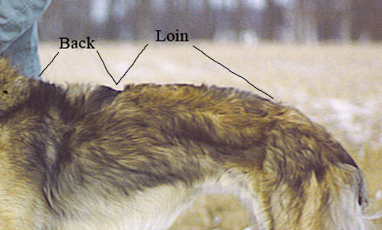 |
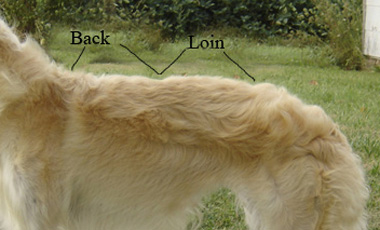 |
| the loin is twice the length of the back (faster) | the loin is nearly the same length as the back (slower) |
Russian standard: BACK is broad, muscled, elastic, forming with the loin and croup a curve which is more pronounced in the males. The highest point of this curve is situated in the region of the first or second lumbar vertebra. LOIN Long prominent, muscled, moderately broad.
AKC standard: BACK: Rising a little at the loins in a graceful curve. LOINS: Extremely muscular, but rather tucked up, owing to the great depth of chest and comparative shortness of back and ribs.
FCI standard ('06) Back: Broad, muscled, elastic, forming with the loin and croup a curve which is more pronounced in the males. The highest point of this curve is situated ahead of the middle of the loin or in the region of the 1st or 2nd lumbar vertebra.. Loin: Long, prominent, muscled, moderately broad.
The next important factor to speed is tight elastic skin. Tighter skin is correlated with increased speed in a direct manner.

Russian standard: SKIN Supple, elastic Faults: insufficiently supple and elastic Serious faults: loose skin
AKC standard NECK: Clean free from throatiness
FCI standard ('06) SKIN : Supple, elastic
Another most important factor to increased speed is high set ears. The closer the ears are set to the top of the skull directly correlates to speed.
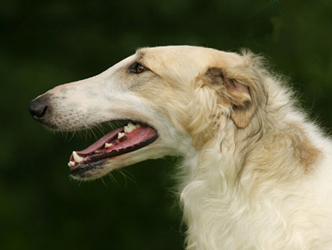 |
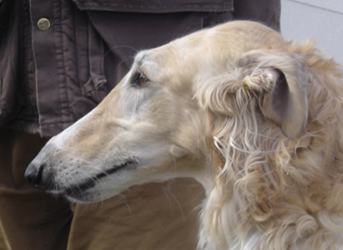 |
| Higher set ears (faster) | Lower set ears (slower) |
Russian standard: EARS Small, supple, mobile, set on or above eye level and backwards...
AKC standard: EARS: Small and fine in quality, lying back on the neck when in repose with the tips when thrown back almost touching behind the occiput; raised when at attention
FCI standard ('06) Ears: Small, thin, mobile, set on above the eye level and backwards....
A very important contributor to speed is having rear symmetry with a proportionally larger croup angle (flatter) to a smaller hock angle (more bend). Another way of describing this is that the faster dog's rears are set further behind the pelvis and less under the pelvis. This also makes the hind legs appear longer in the faster dogs. This variable is already a proportion, so optimal levels are not yet calculated.
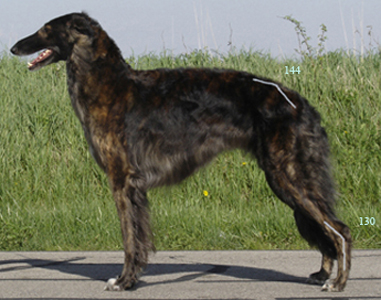 |
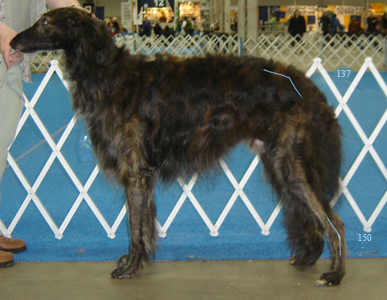 |
| croup angle bigger than hock angle (faster) | croup angle smaller than hock angle (slower) |
Russian standard: CROUP Long, broad, slightly sloping. The width of the croup measured between the two hip bones must not be less than 8 cm. Faults: Narrow, short, steep. Serious Faults: Very narrow, very short excessively steep (goose rump) HINDQUARTERS ... When the dog is standing true, the vertical line dropping from the ischiatic tuberocity must pass in front of the center of the hock joint and of the metatarsals. Upper thigh well muscled, long, placed obliquely. Lower thigh long, muscled, placed obliquely....
AKC Standard: HINDQUARTERS: Long...; strong first and second thigh....
FCI Standard : HINDQUARTERS ... When the dog is standing true, the vertical line dropping from the ischiatic tuberocity must pass in front of the center of the hock joint and of the metatarsals. Upper thigh: well muscled, long, placed obliquely. Lower thigh: long, muscled, placed obliquely.
B. The next grouping of attributes contributes to speed, but have optimal levels. There is no advantage to having greater or lesser values than the optimal.
A significant contributor to speed is the chest. For optimal speed the chest should be slightly wider than half its depth.
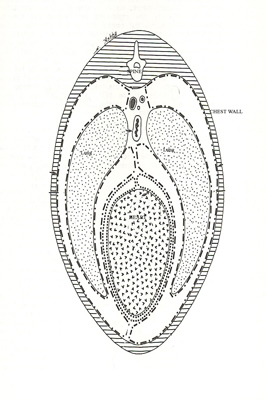 |
| This chest is a drawing showing the thorax at T8 approximating a chest proportion of 6.25 to 12. |
Russian standard: CHEST Of oval cross-section, not narrow, yet not wider than the croup, spacious, reaching down almost to elbow level. The region of the shoulder blades being flatter, the chest gets gradually wider toward the false ribs, which are short; seen in profile it forms a change in slope..... Faults: Chest narrow, flat, not deep, sternal line much higher than the level of the elbows. Serious faults: Chest hollow in its front part, barrel -ribbed.
AKC Standard: CHEST: Rather narrow, with great depth of brisket.
FCI ('06) standard: Chest: Of oval cross-section, not narrow, yet not wider than the croup, spacious, reaching down almost to elbow level. The region of the shoulder blades being flatter, the chest gets gradually wider toward the false ribs, which are short; seen in profile it forms a change in slope.
Another significant contributor to speed is bladed bone. When measured at 2 cm above the carpus the fastest borzoi are 1.5 to 1.6 times deeper than wide (when viewed from the front)
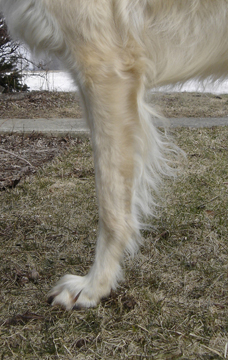 |
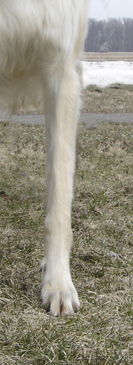 |
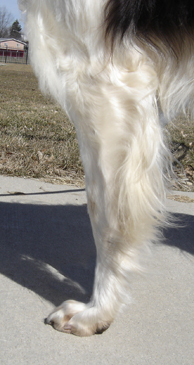 |
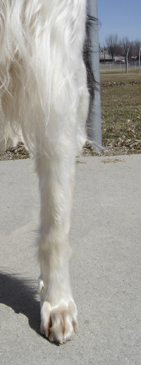 |
| bladed bone (faster) | bladed bone | rounder bone (slower) | rounder bone |
Russian Standard: FOREQUARTERS .... Forearm is clean, long, of oval cross section; seen from the front, narrow; seen in profile, broad..... Serious faults: ...forearm of round cross section.
AKC standard: FORELEGS: Bones straight and somewhat flattened like blades, with the narrower edge forward....
FCI standard ('06) Forearm: Clean, long, of oval cross section: seen from the front narrow, seen in profile, broad.
II. MODERATELY IMPORTANT:
The next variables are more moderate contributors to speed.
Length of croup is in this category. Longer croups are faster.
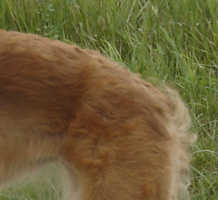 |
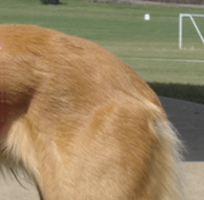 |
| Longer croup (mod. faster) | Shorter croup (mod. slower) |
Russian standard: CROUP Long, broad, slightly sloping... Faults: Narrow, short, steep.
Another moderate contributor to speed is tuck up. Higher tuck ups are faster.
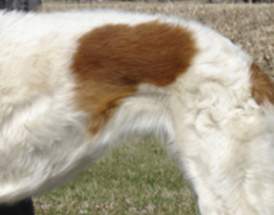 |
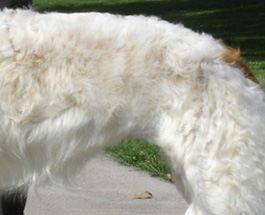 |
| higher tuck up (moderately faster) | lower tuck up (moderately slower) |
Russian standard: ....the chest gets gradually wider toward the false ribs, which are short; seen in profile it forms a change in slope.
AKC standard: LOINS: Extremely muscular, but rather tucked up,
FCI standard Belly: Well tucked up, the underline rises abruptly towards the abdomen.
Pastern angles have an optimum level of 165 degrees.
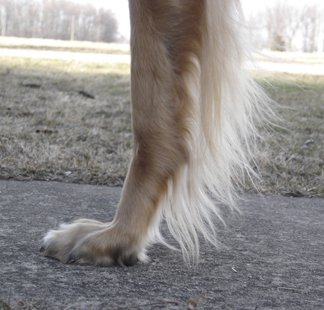 |
| pastern angle 165 degrees (moderately faster) |
Russian standard: Pastern slightly oblique in relation to the ground.
AKC standard: Pasterns strong
FCI standard: Metatarsus (pastern) : Slightly oblique in relation to the ground.
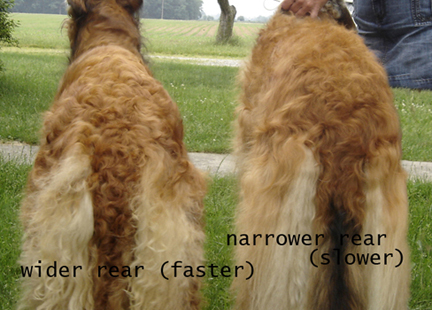
Rear width has an association with speed in this population. Rear widths ranged from 8.25in (21cm) to 10.75in (27cm). Faster dogs had wider rears.
Russian standard: HINDQUARTERS Seen from behind: straight parallel, set slightly wider than the forequarters.
AKC standard: HINDQUARTERS ....somewhat wider than the forequarters...
III. NOT SIGNIFICANTLY IMPORTANT:
Attributes that do not have a significant impact on speed in this population are shoulder angle, height, leg length, loin width, and length of foot. Either these characteristics have little impact on speed or they are within an acceptable range in the borzoi population studied.
Shoulder angle had an optimal level of 120 degrees, but it was not quite significant (p-value of .0723 in table 5).
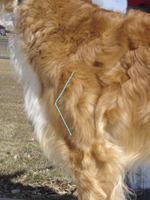 |
| Shoulder angle120 deg. |
Russian standard: FOREQUARTERS Shoulder blades long and oblique, upper arm moderately oblique.... Angle of the scapulo-humeral articulation well pronounced.
AKC standard: SHOULDERS: Sloping, fine at the withers and free from coarseness or lumber.
Height: The height at the withers of the measured borzoi are 68 to 90 cm. Only 5 borzoi out of 191 measured are above 85 cm and none are below 68 cm.
Russian standard: Desirable height at the withers for males: 75-85 cm, for females: 68 - 78 cm.
AKC standard: SIZE: Mature males should be at least 28 inches (71 cm) at the withers and mature bitches at least 26 inches (66cm) at the withers.
Leg (height at elbow/ height at withers) has an average of 0.54 with a range of 0.47 to 0.58. The borzoi in this study have a leg length as described in the Russian standard.
Russian standard: The height of the forelegs from the elbow to the ground is equal or a little superior to half the height at the withers.
Loin width has no observable association with speed in this population.
Russian standard: LOIN Long, prominent, muscled, moderately broad.
AKC standard: LOIN: Extremely muscular, but rather tucked up...
Length of foot does not contribute to speed in this population.
Russian standard: Lean, narrow, of elongated oval shape (called "harefeet"); toes arched, tight.
AKC standard: FEET: Hare-shaped, with well-arched knuckles, toes close and well padded.
Conclusion:
The borzoi as described in the Russian standard is a fast borzoi according to this data. The FCI, AKC, English, and Canadian standards do not disagree with either the Russian standard or the study results but are generally not as explicit; therefore, more subject to personal interpretation. Any interpretation of any borzoi standard that promotes a slower, less functional sighthound would be an incorrect interpretation.

Links to further discussion and details.
e-mail author at teineborzoi@nktelco.net